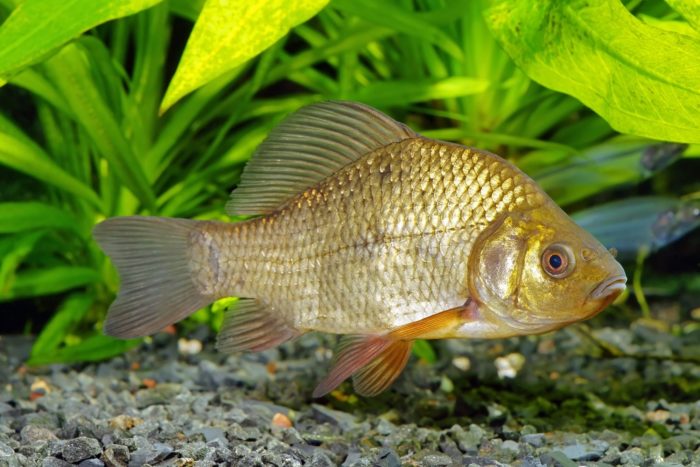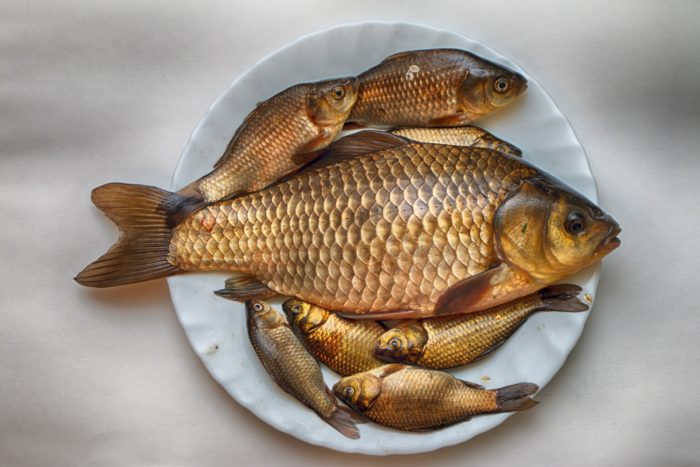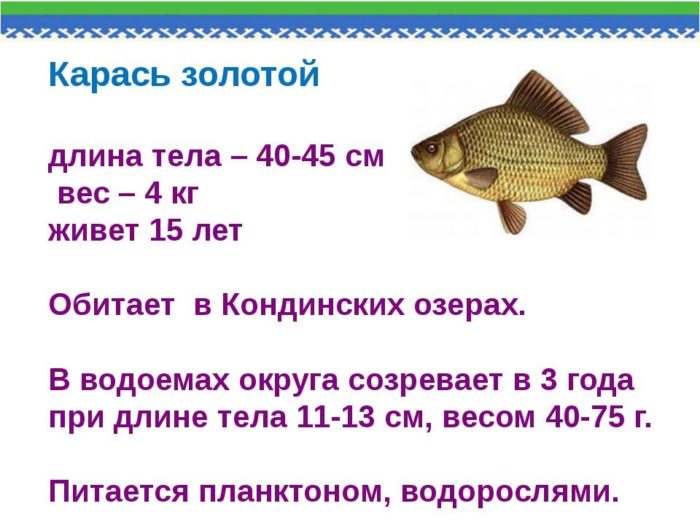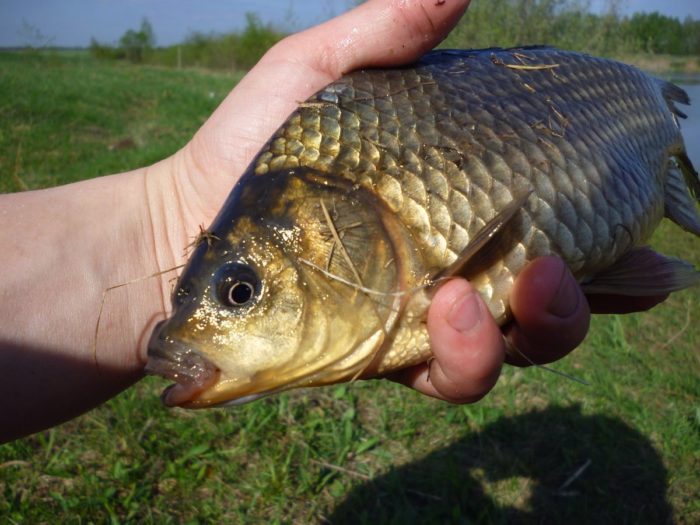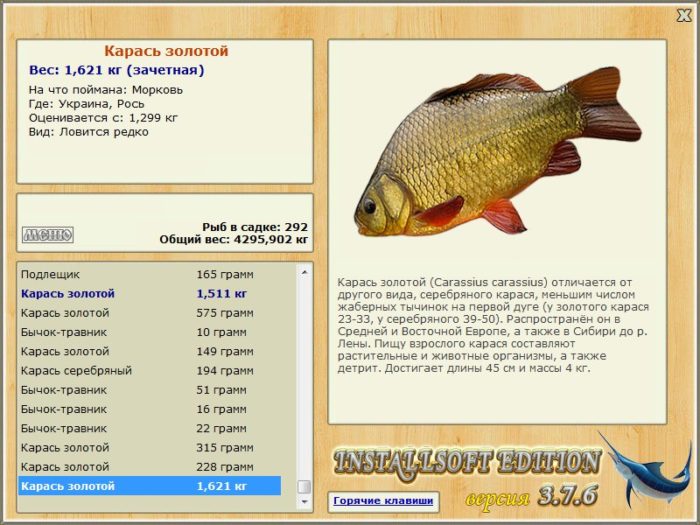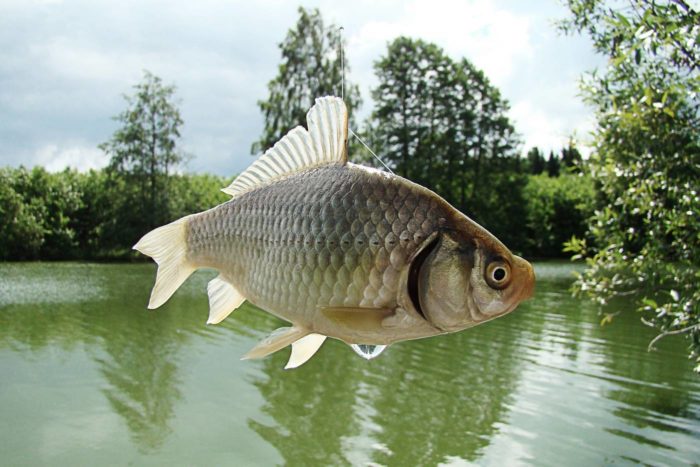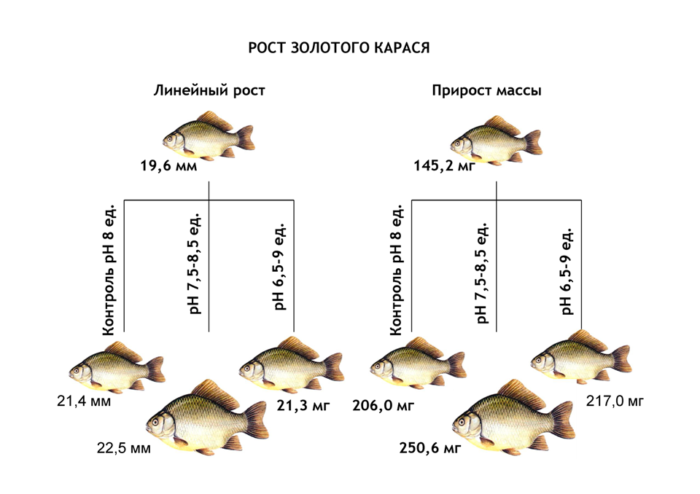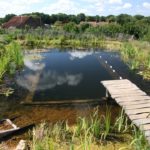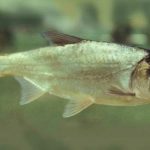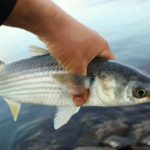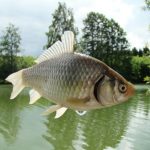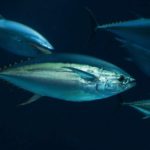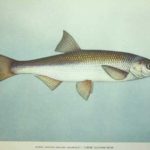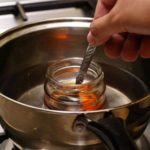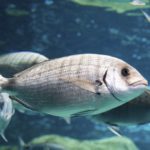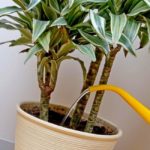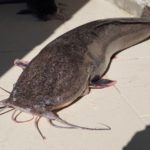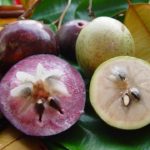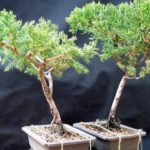When growing fish, crucian carp is considered the best option. This is due to its unpretentiousness. However, some rules still need to be followed. It is important to know exactly how crucian carp grows. To do this, you need to familiarize yourself with the rules for preparing a reservoir and the characteristics of the diet of individuals. If you follow the basic recommendations, you will be able to make crucian carp breeding a fairly profitable business.
Life cycle stages
For the breeding of crucian carp to be a successful process, it is necessary to take into account the main features of the life cycle of this fish. It includes the following:
- The egg stage lasts 2-3 weeks from the start of spawning. During this period, the embryo develops to the point where it can begin to swim. It is important to take into account that the female lays 50-300 thousand eggs, but most of them die at this stage. They are eaten by inhabitants of water bodies. Also, eggs can be carried to inappropriate places in the water area.
- Early fry - this stage lasts 1-2 months after the fish hatches from the egg. At this stage, crucian carp are highly vulnerable and become prey for any predator. If individuals manage to survive this stage, they will continue to develop and increase mass.
- Immature crucian carp - this stage begins at 2 months and lasts up to 1.5-3 years. During this period, under suitable conditions, the fish manages to gain weight up to 300 grams. The older and larger the individuals, the less dangerous predators are for them.
- Sexually mature crucian carp - in males this stage begins at 2-3 years, and in females it starts at 3-4 years. The time at which reproductive age begins is determined by the habitat conditions of the fish in a particular body of water. From this moment on, the next stage in the development of crucian carp is death. It can be natural from old age or due to being eaten by a predator or caught by a person.
How to choose a breeding pond
When breeding crucian carp, every person is faced with the problem of choosing a pond. In general, even a small pond is suitable for these individuals. However, it should be quite deep. However, it is unlikely that anyone plans to breed 2-3 crucian carp. The size of the pond determines how many fish you can put in there.In addition, the area of the reservoir affects the size of individuals, which they will reach by 3-4 years.
The minimum area of the pond is 10-15 square meters. However, it is important to consider that the larger the size of the reservoir, the more fish will be able to grow in it. Experienced breeders recommend using the calculation - 1 ton of fish per 40 tons of water. Of course, under natural conditions, crucian carp will not be able to live in such conditions, since they simply do not have enough food. However, it is much easier to solve this problem at home. It is much easier to provide individuals with food than to dig a reservoir of several hectares.
How to prepare it
When arranging a pond for raising crucian carp, it is recommended to take into account the following features:
- Small ponds require serious maintenance, while large ones will be expensive to maintain. Therefore, the optimal size is 30-50 square meters.
- It is important that one of the areas of the reservoir is located in the shade.
- In spring, the pond should not be flooded. To do this, it needs to be placed in an elevated place.
- It is imperative to create a complex bottom topography. For wintering you will need a deep-water hole. It is also important to provide a shallow area where the fish will receive food.
- The soil must be selected depending on the type of fish. For example, crucian carp needs silt, since in natural conditions it prefers to bury itself in a silty cushion at the bottom in winter.
Water is considered the most important component of successful cultivation of crucian carp. Without it, it will not be possible to organize a mini-farm. Therefore, before deciding to breed crucian carp in a private pond, it is necessary to create a suitable artificial reservoir.
To arrange a reservoir at your dacha, you need to determine its location.It is recommended to choose it in such a way that the following requirements are met in the summer:
- from dawn to 10 am the place should be illuminated by the sun;
- from 11 a.m. to 3 p.m., the pond should be located in partial shade.
Warm water is bad for the health of fish. In addition, it leads to the development of algae and oxygen deficiency. Therefore, the future tank should be located closer to the shade of trees. It is better for the shadow to fall on the water in the afternoon, when it is very hot. It is not recommended to specifically plant trees, since during growth their roots can damage the pond. In addition, falling leaves will begin to rot and spoil the water.
When constructing a country pond, it is necessary to take into account the following basic dimensions:
- depth - at least 1 meter, but it is better to do a little more, as this will provide the fish with a sufficient amount of oxygen for breathing;
- length – approximately 5 meters;
- width - about 6 meters.
A significant size of the reservoir is required so that crucian carp do not experience oxygen deficiency. It is produced by aquatic crops. However, in winter they develop with difficulty. To provide the crucian carp with air, it is necessary to place reeds and tufts of straw in the pond. You can also make recesses through which air can enter the water structure.
In addition, a deep reservoir helps maintain the health of the fish. In winter, it will not freeze, and in summer, deep depressions at the bottom will help the fish shelter from the heat, since the water warms up unevenly. Also, following this recommendation will help slow down water blooms associated with the active development of pathogens under the sun's rays.
Once you have decided on the size of the tank for the fish farm, you should start digging a hole. It is recommended to consider the following:
- If you plan to make a large pond, you should use a bulldozer.
- A dense and clayey area is suitable for the work. It is important that the soil does not crumble. Clay is considered the best material that holds its shape well.
- After digging a pit, it needs to stand for several weeks. This will compact the soil.
- To facilitate subsequent maintenance, the bottom of the tank must be made rounded. This will help eliminate places where debris can accumulate. Such areas will be difficult to clean.
- The bottom of the reservoir must be compacted. It is important to consider that for crucian carp the pond should be made uneven. This can be taken into account at the excavation stage or after the tank is concreted. In this case, it is worth pouring a soil layer there. It is also permissible to cover the bottom of the reservoir with film. This will help avoid cementation.
In addition, you can buy synthetic mats that are made from coconut shavings. It is recommended to place such products at the bottom. After which you should place silt and algae on them. This will help saturate the pond with oxygen and provide the fry with shelter.
After creating the reservoir, it needs to be filled with water. To do this, it is recommended to do the following:
- Fill the container one third full. In this case, it is permissible to use water from a well, spring or river.
- Improve the bottom. In this case, you need to pour sand and plant algae.
- Fill the pond completely with water.
- Start developing the coastal area. It is recommended to plant reeds and cattails there.
- To breed crustaceans, place stones or broken pots on the bottom. They will become a reliable refuge for such individuals.
It is important to provide for chemical cleaning of the pond from harmful organisms. For disinfection, use quicklime.For 1 hectare it is worth using 900-1125 kilograms of this substance. 5-10 days before settling the reservoir, it is worth applying organic fertilizer. Its functions can be performed by compost or animal manure. Thanks to this, it will be possible to increase the biomass of natural food organisms – zooplankton. It is recommended to use 3000 kilograms of manure or 4500 kilograms of compost per 1 hectare.
After preparing the pond, it is necessary to introduce beneficial microflora there. A neutral environment is necessary for its development. Acidity parameters should be 7-8 pH. If this indicator is less than 5, it is worth adding lime to the reservoir. Before introducing fish into the pond, it is necessary to achieve the correct level of acidity and heating. This will help avoid temperature shock.
How many crucian carp do you need to launch?
Crucian carp are considered very unpretentious individuals in terms of care. Therefore, they can be safely grown in home conditions. It is not surprising that such individuals are often bred in artificial reservoirs.
You can also add the following types of fish to a homemade pond:
- freshwater trout;
- tench;
- gold fish.
Carp develops well in a small pond and gains weight better in such a pond. You can easily feed him and monitor his weight gain. The pond will require sunlight with slightly alkaline water.
At the same time, to breed crucian carp you will need a pond with standing water. It must certainly contain a large number of different plants. The dimensions of the tank should be the same as when growing carp. It should be borne in mind that it is forbidden to house crucian carp with tench. These fish compete for the same food.
In low-flow ponds, it is permissible to keep crucian carp in a monoculture.In this case, per 1 square meter there should be 2-5 fingerlings and 1-2 two-year-olds. As an additional fish, crucian carp are grown at sparse stocking densities. As a rule, the following standards are observed: 0.5 pieces for fingerlings and 0.1 for two-year-olds per 1 square meter.
Other breeding areas
Most often, crucian carp are bred at home in an ordinary pond. If there is a public reservoir nearby, you can fence off part of the area in it using metal sheets. It's called a "cage". However, in this case, there is a chance that other fishermen will catch the fish.
To grow crucian carp, you can even use an ordinary metal container or a large barrel. It is important to take into account that it will not be possible to breed a lot of fish in such containers. This is more suitable when growing crucian carp for yourself. In addition, it is worth considering the following:
- the container must be of sufficient size for the fish;
- it is important that there is a layer of silt at the bottom;
- the depth must be at least 1.5 meters;
- It is important to provide a normal number of plants - without this, crucian carp will face oxygen deficiency.
Reproduction methods
To properly launch a mini-farm, it is worth taking into account the stages of fish development. This will help improve the result:
- first, fish spawn;
- after that it turns into fry;
- then the individuals gain a mass of approximately 200 grams;
- after which the fish leaves for the winter;
- with the onset of spring, the next year of development begins - many people consider this stage to be the final stage and move on to catching.
Today, artificial propagation is considered the main source of obtaining crucian carp. To do this you will need the following individuals:
- goldfish;
- goldfish.
These individuals can interbreed and form hybrid offspring.According to ichthyologists, a male golden crucian and a female silver crucian bring female offspring. Moreover, the growth rate of such individuals is 30-40% higher than that of the parents.
It is necessary to provide a separate place for spawning in the reservoir. After a while, the grown fish are moved to the main pond. It is also permissible to use a plastic pool for breeding crucian carp.
Incubation production involves the following stages:
- Selected mature fish are released into the tanks for spawning. They do not need to take hormone injections, since crucian carp reproduce well as is. If you still resort to this method, the fish will begin to reproduce synchronously. Thanks to this, the fry will hatch almost at the same time.
- The female attaches the eggs to aquatic vegetation. To speed up hatching, you can place the individual in a pond with running water. In this case, the substrate with the eggs attached can be placed in water in a jar. This will help keep it safe from other fish. When the fry hatch and grow a little, they can be released into the water.
The planting density of caviar is usually 1.5-2.25 million pieces per hectare. The specific amount is determined by the length of the growing period. The later the fish are planned to be retrieved, the less caviar is used.
Young crucian carp grow up to 30 millimeters 2-3 weeks after hatching. Such individuals are called summer fry. After being transferred to a regular pond, they need to be kept in a pen. This will help minimize stress.
All young animals of the current year are called fingerlings. Summer fry should not be kept in adult ponds. First, they need to be grown to the desired size - 6-7 centimeters or more.
It is permissible to raise fry using the following methods:
- To produce marketable fish, which grows within the first year, fry are introduced into the pond. At the same time, 90-120 thousand individuals are required per 1 hectare. After a month they grow up to 6 centimeters. After which it is recommended to move the fish to a large pond.
- You can also raise the fry in your own pond. In this case, it is worth planting 150-300 thousand eggs per 1 hectare in a children's pond. Such fry are used for commercial use next year. As a result, fish with a two-year development cycle reach larger sizes than those with a one-year development cycle. In addition, its cost increases.
By the end of the first year of development, young individuals will grow to 150-400 grams. In this case, production can reach 4000 kilograms per 1 hectare. In the second year, this parameter is 3000-4500 kilograms per hectare. As a result, the overall productivity is at the level of 6000-10000 kilograms per hectare.
Recommendations for beginners
Speed Fish growth depends on many factors. In order for crucian carp to develop normally, they need to be fed properly and provided with suitable conditions.
Feeding
To raise productive fish, they need to be provided with a suitable diet. It must include feed mixtures. However, some fish farmers make up their diet only from natural products. Grains, legumes, and cereals are used for this.
Fish also needs an optimal ratio of minerals and vitamins. To do this, the pond needs to be mineralized and fertilized. Feed additives should be used depending on age. It is also important to pay attention to strengthening the immune system. To do this, you need to use supplements to treat stress and engage in disease prevention.
The fry that have just hatched have a yolk sac. He provides them with resources for at least 2 days. The fish then begin to absorb microorganisms in the water. As a rule, fry perfectly distinguish phytoplankton from zooplankton and give preference to the latter. If there is a lack of natural plankton, the fish must be fed with flour. It is recommended to mix wheat, soy, meat and bone and fish bone.
Farmers often use granulated food to feed crucian carp. Moreover, it has different types. For fry, it is worth using starter food, for adults - productive food, which promotes weight gain.
Preparing for winter
As the temperature of the water in the country decreases, the fish move to depth. Snags and bottom holes are suitable for them for wintering. Such individuals can burrow into the silt and doze there until the sun begins to warm the water.
In autumn, under the influence of changes in temperature, fish begin to accumulate glycogen in the brain. This allows you to maintain performance and health from February to April, when there is a deficiency of oxygen in the pond. This substance helps cope with oxygen starvation.
It is important to take into account the activity of fish. Natural crucian carp reduce their activity with the arrival of winter. At the same time, hybrids of silver and golden varieties remain active for a long time. Therefore, it is important to provide them with sufficient food and oxygen.
Nuances of cultivation
In order for the fish to develop normally, it is important to monitor its health. Crucian carp can be grown both in a pond and in barrel. In any case, they need to create the correct water regime.In this case, you need to focus on temperature parameters, mineralization, acidity, and the amount of oxygen. It is important to ensure that the reservoir does not contain methane or hydrogen sulfide. These substances can be released under appropriate conditions.
Aquatic plants are considered an essential element. They contribute to the health of the reservoir, absorb phytopathogens and promote filtration. Caring for the fish itself includes feeding and periodically cleaning the pond. However, the procedure is carried out when the previous individuals have already been caught, and new ones have not yet been launched.
How profitable is this business?
Contain crucian carp are quite profitable because they are considered undemanding and omnivorous. Other advantages of such individuals include the following:
- absence of cannibalism;
- disease resistance;
- rapid weight gain;
- no competition for food;
- feeding with inexpensive feed;
- moving and obtaining food in different layers of a reservoir.
Many people farm fish for themselves. However, this business can also be considered as a profitable business. If it is not possible to dig a pond, you can use a plastic pool. It needs to be installed in a polycarbonate greenhouse. You also need to buy filtering and compressor equipment, which will require some costs. Specific amounts depend on the power of the units.
So, to breed fish you will need the following:
- Biofilter is a device that helps purify water. It will take just a few minutes to install it. Thanks to filtration, the fish will not die from toxins that are formed during the breakdown of food, living creatures and algae.
- Compressor – provides water movement.
- Ultraviolet sterilizer - helps to cope with flowering.
- Fish feeder - helps to avoid waste of food and prevent its disintegration in the pond.
The development of crucian carp has a number of characteristic features. In order for the breeding of these fish to be successful, it is important to become familiar with the main stages of their life cycle. Providing suitable conditions and the right diet is of no small importance.

